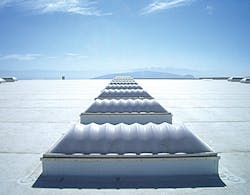The Impact of Tubular Daylighting on Energy and LEED
Daylighting is a popular energy-saving element because of its simple application, significant cost savings, and ability to create healthy, enjoyable spaces. But don’t remain in the dark about which daylighting methods are most effective.
Natural light can be provided via side or top lighting. The former is offered through windows, which are limited by orientation, shifting patterns of light, and issues of consistency and glare related to variations in time, season, or exterior conditions.
The latter offers more evenly distributed daylight by harnessing it from the roof. One of the most efficient types of top lighting comes from tubular devices. They capture light with a dome and transfer it long distances. They are even effective at gathering light from low angles during unfavorable times of the day.
In addition to energy savings that can approach 90% by reducing electric light loads, according to manufacturer Solatube, light tubes can help earn several LEED certifications. Selling a daylighting retrofit as a sustainable measure that increases occupant satisfaction may help the project get approved faster than energy reduction alone. Learn from the following success stories to consider a project at your facility.
- Recreational Equipment, Inc. (REI) is a retail store that wanted to prove its commitment to the great outdoors by enhancing its stores with natural light. Its Boulder, CO, location also wanted to cut energy use and achieve accurate CRI to increase purchases. A light tube retrofit achieved these goals and helped earn LEED-EB 2009 Gold designation.
- A Subway restaurant in Kissimmee, FL, recently became the first of the franchise to achieve LEED Silver certification, earning Core and Shell 2009 status with a contribution from tubular daylights. The natural light also provides an enjoyable atmosphere for customers and makes the food appears more appetizing.
- Focus Lighting, Inc., an architectural lighting design firm in New York City, wanted to use its own office as a showcase for daylighting strategy and provide a comfortable workspace for employees. Light tubes met these desires while contributing to LEED Silver for Commercial Interiors 2009.
- After a tornado devastated much of Greensburg, KS, the John Deere dealership there aimed to rebuild with sustainability in mind. A tubular daylighting installation contributed to LEED for Retail New Construction Platinum, and also helped achieve roughly 40% in energy savings. Energy modeling showed costs for the building to be $47,000 per year if it were built to code. Now that natural light accommodates over 90% of the space, its annual energy bill is projected at $24,000.
Tubular daylighting lets you have high light levels without the burden of a huge electrical load. It’s a little like having your cake and eating it too – a LEED plaque is just the icing on top.
